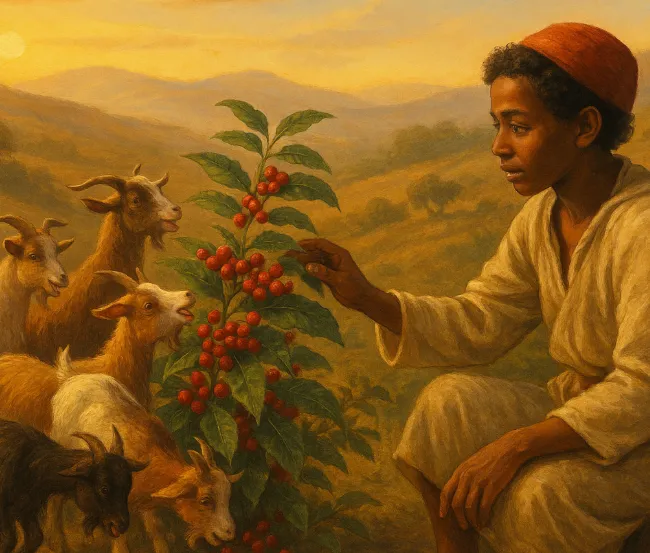The Legend of Kaldi: How Coffee Was Discovered in Ethiopia - Complete Origins Story
Discover the legendary story of Kaldi the goat herder and how coffee was first discovered in Ethiopia. Learn about coffee origins, the dancing goats legend, and how this energizing beverage spread from Ethiopian monasteries to the world.
- Coffee Basics Nerds
- 4 min read

The Legend of Kaldi: How Coffee Was Discovered in Ethiopia
Ever wondered how coffee was discovered? The most captivating story takes us back to 9th-century Ethiopia, where a curious goat herder named Kaldi made a discovery that would change the world forever. While the coffee origins explained through this legend may be more myth than fact, it beautifully captures the essence of coffee’s Ethiopian roots and humanity’s first encounter with this energizing beverage.

The Dancing Goats: A Discovery That Changed Everything
The Kaldi coffee legend begins with an observant goat herder in the Ethiopian highlands. Kaldi noticed something unusual about his flock - after eating red berries from a particular shrub, his goats began displaying extraordinary energy and playfulness, almost as if they were dancing.
What Made the Goats “Dance”?
- Caffeine-rich berries: The goats had discovered coffee cherries containing natural caffeine
- Unusual behavior: Instead of their typical calm demeanor, the goats became animated and exuberant
- Kaldi’s curiosity: This dramatic change in behavior caught the herder’s attention immediately
The dancing goats coffee story illustrates humanity’s natural curiosity about the world around us. Kaldi’s decision to investigate further would lead to one of history’s most significant discoveries.
Kaldi’s Experiment: The First Human Coffee Experience
Intrigued by his goats’ transformation, Kaldi decided to try the mysterious berries himself. According to the Ethiopian coffee origins legend, he soon experienced the same energizing effects that had captivated his flock.
This moment represents the first recorded human encounter with coffee’s stimulating properties - a discovery that would eventually spread across continents and cultures.
From Goat Herder to Monastery: How Coffee Spread
The legend continues with Kaldi sharing his discovery with a local Ethiopian monastery. Initially skeptical, the monks threw the berries into a fire, dismissing them as potentially dangerous. However, the roasting coffee beans aroma that emerged was so captivating that they quickly changed their minds.
The First Primitive Coffee Brewing
The monks’ accidental discovery led to the first coffee preparation method:
- Rescued from flames: They raked the aromatic beans from the fire
- Ground the beans: Using primitive tools to break down the roasted coffee
- Mixed with hot water: Creating the world’s first cup of coffee
- Stayed alert for prayers: Used the energizing brew to maintain focus during long spiritual sessions
This monastic connection established coffee’s early association with spiritual practices and enhanced alertness - themes that continue to resonate in modern coffee culture.
The Historical Reality Behind the Legend
While the Kaldi legend coffee story captures our imagination, it’s important to understand its place in coffee history:
What We Know vs. What’s Legend
- No historical evidence: There are no documented records confirming Kaldi’s existence
- Ethiopian origins confirmed: Archaeological and botanical evidence strongly supports Ethiopia as coffee’s birthplace
- Cultural significance: The legend reflects the deep connection between Ethiopian culture and coffee
- Symbolic truth: Even if not factually accurate, the story embodies the wonder of coffee’s discovery
Coffee’s Journey from Ethiopian Legend to Global Phenomenon
The coffee history timeline shows that regardless of the legend’s accuracy, coffee’s Ethiopian origins are well-established. From these highland beginnings, coffee would eventually:
- Spread to Yemen and the broader Middle East
- Travel along ancient trade routes to Europe
- Transform social customs through coffee house culture
- Influence global trade through colonial coffee production
Why the Kaldi Legend Endures
The story of Kaldi and his dancing goats continues to resonate because it:
- Celebrates discovery: Highlights human curiosity and willingness to experiment
- Honors Ethiopian heritage: Recognizes the true birthplace of coffee culture
- Explains the inexplicable: Provides a charming origin story for coffee’s energizing effects
- Connects past and present: Links modern coffee enjoyment to ancient discoveries
The Legacy of Coffee’s Ethiopian Origins
Understanding how coffee was discovered - whether through Kaldi’s legend or other means - helps us appreciate coffee’s rich cultural heritage. Ethiopia remains central to coffee culture today, producing some of the world’s most prized beans and maintaining traditional brewing methods that echo these ancient origins.
The journey from Kaldi’s curious goats to your morning cup represents thousands of years of cultivation, refinement, and cultural exchange. This Ethiopian coffee discovery story reminds us that every cup connects us to a legacy of human curiosity and the transformative power of simple observations.
Learn more about coffee’s fascinating journey through history in our comprehensive guides to early coffee brewing methods and how coffee spread from the Middle East to Europe.
You might also like:
- Tags:
- Coffee Discovery
- Ethiopia Coffee
- Kaldi Legend
- Coffee Origins Explained
- Coffee History Timeline
- Ethiopian Coffee Culture
- Coffee Beans
- Hot Water
- Coffee Culture
- Coffee Brewing
- Roasted Coffee
- Coffee Production
- Brewing Methods
- Middle East
- Modern Coffee
- Cup Coffee
- Global Trade
- Cultural Heritage
- Coffee History
- Cultural Significance
- Coffee House
- Coffee Preparation
- Coffee Experience
- Coffee Journey
- Traditional Brewing
- Coffee Fascinating
- House Culture